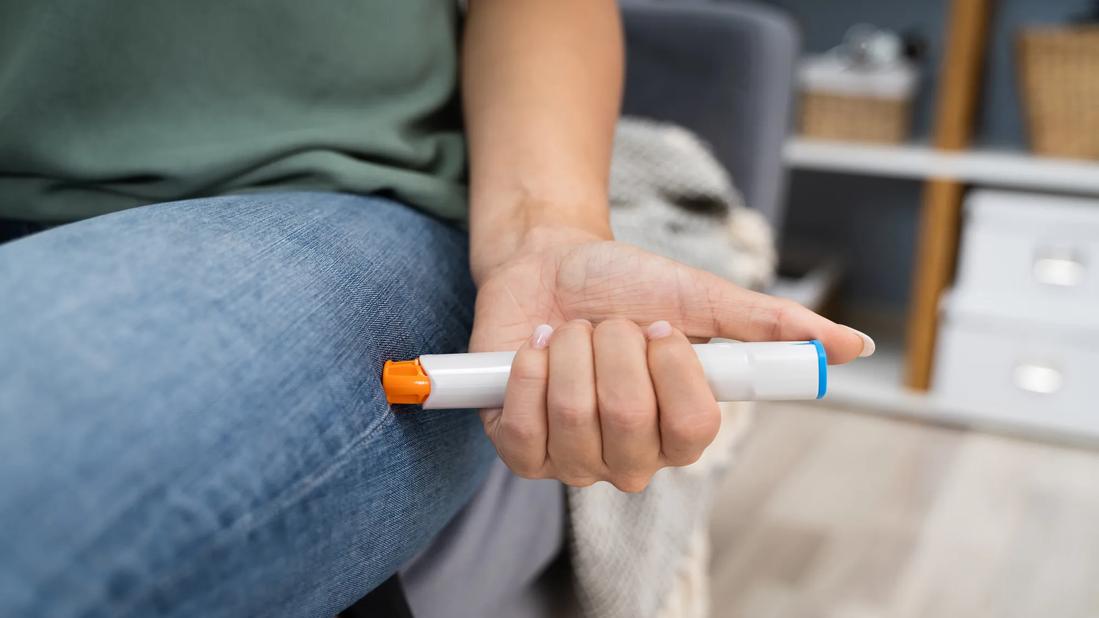You can now get lifesaving epinephrine in a nasal spray and prefilled syringes

If you have a serious allergy, having an EpiPen® on hand can mean the difference between life and death. But they expire within just 12 to 18 months — and between cost and availability issues, it can be tough to get your hands on a new one.
Advertisement
Cleveland Clinic is a non-profit academic medical center. Advertising on our site helps support our mission. We do not endorse non-Cleveland Clinic products or services. Policy
Are there safe, effective and less-expensive alternatives to an EpiPen for treating anaphylaxis? The answer is yes, according to pediatric allergist Bridget Wilson, MD.
Dr. Wilson shares the options currently on the market and how to decide which one is best for you.
If the cost of an EpiPen is too steep for you, if there’s a shortage in your area or if you struggle to use the device, Dr. Wilson recommends asking your allergist about alternative epinephrine products.
There’s one option they’ll likely advise against: Buying an old-school epinephrine vial and syringe is the most affordable option — but it’s not recommended for safety reasons. There are a lot of opportunities for human error with a DIY approach, like getting the dosage wrong or struggling to switch needles.
“When you’re in the middle of an anaphylactic reaction, you may not be able to self-administer the epinephrine quickly,” Dr. Wilson explains. “And you can’t assume that people around you know how to dose and inject your medication.”
So, that’s one option off the table. But it’s not the only game in town. Your provider will probably mention these, too:
Neffy®, the first-ever epinephrine nasal spray, is a new entry into the market, having only received U.S. Food and Drug Administration (FDA) approval in August of 2024. Instead of injecting medicine into your skin and muscle, Neffy users spray a single pump of liquid epinephrine into one of their nostrils.
Advertisement
There are lots of reasons to consider using Neffy as an alternative to an EpiPen or other injectable epinephrine product, Dr. Wilson observes. Neffy:
Of course, Neffy has its drawbacks, too. There’s a possibility you could have problems administering it, as the way you use it is slightly different from some other types of nasal sprays. And you may have side effects like runny nose, throat irritation and mouth numbness instead.
Also, Neffy is a relatively new medication. Dr. Wilson notes that more research is needed to understand how effective it is in treating people with allergic reactions.
“Since we are still learning about Neffy, it’s important to talk with your allergist about your care plan,” she advises. “Your allergist may recommend keeping injectable epinephrine as a back-up option in addition to Neffy.”
Also, be sure to tell your provider if you’ve ever broken your nose, had nasal surgery or have structural issues like polyps, as these could interfere with medication absorption.
While they’re definitely the most popular brand, EpiPens aren’t the only epinephrine auto-injectors on the market.
“Alternative devices that also contain epinephrine will keep you and your kids safe,” Dr. Wilson says. Other brands to consider include:
Advertisement
Again, each auto-injector dispenses medication a little differently. That’s why it’s important to have — and use — a trainer (more on that in a bit).
If you want the convenience of a syringe but worry about fiddling with a vial in an emergency, you might want to consider Symjepi®, which is a pre-filled syringe.
To use Symjepi, you remove the cap and manually inject the epinephrine into the skin and muscle of your outer thigh by depressing a plunger.
Symjepi is a bit more labor-intensive than an auto-injector and not as widely available as brand-name EpiPens and other epinephrine auto-injectors. Unlike epinephrine auto-injectors, the needle on Symjepi is exposed. But it’s typically more affordable.
If cost is your main concern, Dr. Wilson recommends asking your provider about authorized generics of the EpiPen or Adrenaclick. An authorized generic is the exact same medication sold by the same manufacturer. The only differences? The product’s name and price point.
Having a wide variety of epinephrine products on the market means that anaphylaxis care doesn’t have to be one-size-fits-all. So, it’s important to work with your allergist to determine the approach that’s going to be safest and most effective for you.
Advertisement
Dr. Wilson says those conversations should touch on the following topics:
Advertisement
There are more ways to administer epinephrine in an emergency than ever before. And still more products are expected to hit the market in the next few years. Whatever option you go with, give yourself plenty of time to get comfortable using it.
“You never know when a reaction will occur — and minutes can make a big difference,” Dr. Wilson emphasizes. “Being trained and comfortable administering epinephrine can save valuable time, so be sure to discuss all of your options and practice using them with your allergist. And always check the expiration date on your medications to make sure they are up to date.”
Learn more about our editorial process.
Advertisement

Learn more about the signs and managing this condition

Allergies, indigestion and the effects of gravity can all mess with your nose at night

Open the windows, keep a clean house and consider putting in preventive features like carbon monoxide detectors

Neti pots can be useful for sinus pressure relief and removing excess mucus

An allergist can help you make a plan that includes information about what to do in case of an allergic emergency

You may notice itching, redness and swelling after wearing or using laundered items

Checking the weather, pollen counts and air quality can help you avoid asthma triggers

Drowsiness is a side effect of inflammation, disrupted sleep and, sometimes, your allergy medicine

The best parenting style balances enforcing rules and showing plenty of love

Tips include cutting back on sugar, focusing on exercise and managing stress

It can be harder to let go when you’ve invested time, energy and emotions — but it might be the healthier choice long term